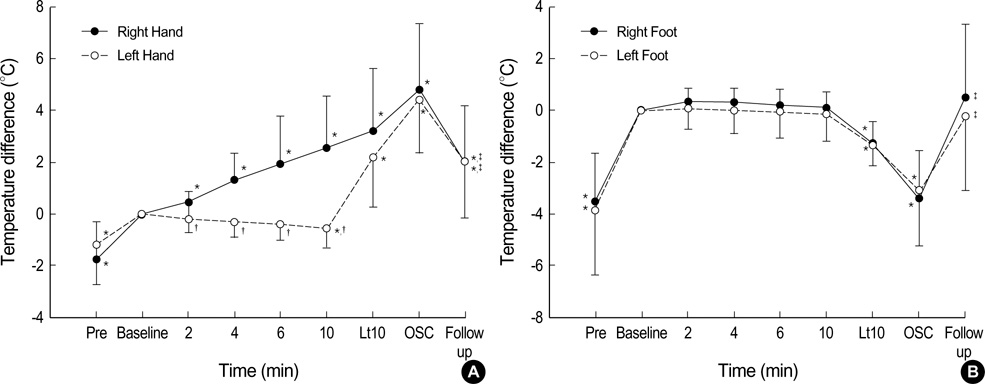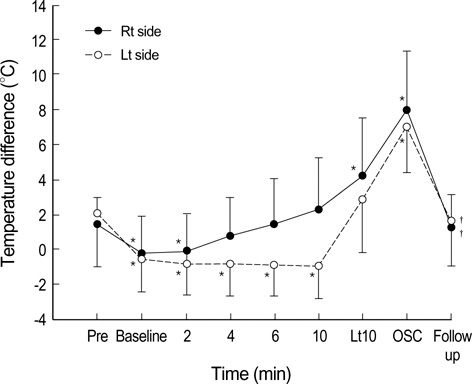J Korean Med Sci.
2006 Oct;21(5):917-921. 10.3346/jkms.2006.21.5.917.
The Changes of Skin Temperature on Hands and Feet During and after T3 Sympathicotomy for Palmar Hyperhidrosis
- Affiliations
-
- 1Department of Anesthesiology and Pain Medicine, College of Medicine, University of Ulsan, Asan Medical Center, Seoul, Korea. icchoi@amc.seoul.kr
- 2Department of Anesthesiology and Pain Medicine, College of Medicine, University of Konkuk, Seoul, Korea.
- KMID: 1781915
- DOI: http://doi.org/10.3346/jkms.2006.21.5.917
Abstract
- Unilateral thoracic sympathectomy in patients with palmar hyperhidrosis causes a skin temperature drop in the contralateral hand. A cross-inhibitory effect by the post-ganglionic neurons innervating hands is postulated as a mechanism of contralateral vasoconstriction. The purpose of our study was to evaluate whether this cross-inhibitory effect also occurs in the feet. Twenty patients scheduled for thoracoscopic sympathicotomy due to palmar hyperhidosis were studied. Right T3 sympathicotomy was performed first, followed by left T3 sympathicotomy. The thenar skin temperatures of both hands and feet were continuously monitored using a thermometer and recorded before induction of anesthesia, during the operation, 4 hr after and 1 week later. Following right T3 sympathicotomy, the skin temperature of the ipsilateral hand gradually increased, however the skin temperature of the contralateral hand gradually decreased. Immediately after bilateral sympathicotomy, the skin temperature differences between hands and feet increased, but these differences decreased 1 week later. Our results show that cross-inhibitory control may exist in feet as well as in the contralateral hand. Thus, the release of cross-inhibitory control following T3 sympathicotomy results in vasoconstriction and decrease of skin temperature on the contralateral hand and feet. One week later, however, the temperature balance on hands and feet recovers.
Keyword
MeSH Terms
Figure
Reference
-
1. Doolabh N, Horswell S, Williams M, Huber L, Prince S, Meyer DM, Mack MJ. Thoracoscopic sympathectomy for hyperhidrosis: indications and results. Ann Thorac Surg. 2004. 77:410–414.
Article2. Dumont P, Denoyer A, Robin P. Long-term results of thoracoscopic sympathectomy for hyperhidrosis. Ann Thorac Surg. 2004. 78:1801–1807.
Article3. Chuang KS, Liu JC. Long-term assessment of percutaneous stereotactic thermocoagulation of upper thoracic ganglionectomy and sympathectomy for palmar and craniofacial hyperhidrosis in 1742 cases. Neurosurgery. 2002. 51:963–970.
Article4. Lu K, Liang CL, Lee TC, Chen HJ, Su TM, Liliang PC. Changes of bilateral palmar skin temperature in transthoracic endoscopic T-2 sympathectomy. J Neurosurg. 2000. 92:44–49.
Article5. Kao MC, Tsai JC, Lai DM, Hsiao YY, Lee YS, Chiu MJ. Autonomic activities in hyperhidrosis patients before, during, and after endoscopic laser sympathectomy. Neurosurgery. 1994. 34:262–268.
Article6. Wu JJ, Hsu CC, Liao SY, Liu JC, Shih CJ. Contralateral temperature changes of the finger surface during video endoscopic sympathectomy for palmar hyperhidrosis. J Auton Nerv Syst. 1996. 59:98–102.
Article7. Yoon SH, Rim DC. The selective T3 sympathicotomy in patients with essential palmar hyperhidrosis. Acta Neurochir (Wien). 2003. 145:467–471.
Article8. Bonjer HJ, Hamming JF, du Bois NAJJ, van Urk H. Advantages of limited thoracoscopic sympathectomy. Surg Endosc. 1996. 10:721–723.
Article9. Hsia JY, Chen CY, Hsu CP, Shai SE, Yang SS. Outpatient thoracoscopic limited sympathectomy for hyperhidrosis palmaris. Ann Thorac Surg. 1999. 67:258–259.
Article10. Satinoff E. Neural organization and evolution of thermal regulation in mammals. Science. 1978. 201:16–22.
Article11. Holzer P. Morris JL, Gibbins IL, editors. Control of the cutaneous vascular system by afferent neurons. The Autonomic Nervous System. Autonomic Innervation of the Skin. 1997. Vol 12. Amsterdam: Harwood Academic;213–267.12. Hornyak ME, Naver HK, Rydenhag B, Wallin BG. Sympathetic activity influences the vascular axon reflex in the skin. Acta Physiol Scand. 1990. 139:77–84.
Article13. Kaya D, Karaca S, Barutcu I, Esen AM, Kulac M, Esen O. Heart rate variability in patients with essential hyperhidrosis: dynamic influence of sympathetic and parasympathetic maneuvers. Ann Noninvasive Electrocardiol. 2005. 10:1–6.
Article14. Wiklund U, Koskinen LO, Niklasson U, Bjerle P, Elfversson J. Endoscopic transthoracic sympathicotomy affects the autonomic modulation of heart rate in patients with palmar hyperhidrosis. Acta Neurochir (Wien). 2000. 142:691–696.
Article15. Janig W, Kummel H. Organization of the sympathetic innervation supplying the hairless skin of the cat's paw. J Auton Nerv Syst. 1981. 3:215–230.16. Sellgren J, Ejnell H, Elam M, Ponten J, Wallin BG. Sympathetic muscle nerve activity, peripheral blood flows, and baroreceptor reflexes in humans during propofol anesthesia and surgery. Anesthesiology. 1994. 80:534–544.
Article17. Gazelius B, Stange K, Lind G, Meyerson BA, Linderoth B. Endoscopic transthoracic sympathicotomy and peripheral microcirculation: effects of electric sympathetic chain stimulation, thermocoagulation and anaesthetic agents. Acta Neurochir (Wien). 2002. 144:589–594.
Article
- Full Text Links
- Actions
-
Cited
- CITED
-
- Close
- Share
- Similar articles
-
- Temperature Changes in Hands and Feet during and after T3 Sympathicotomy for Palmar Hyperhidrosis
- Long-term Follow-up of Limited T3 Symathicotomy in Palmar Hyperhidrosis
- Changes in Both Palmar Skin Temperature during Video Endoscopic Thoracic Sympathicotomy for Hyperhidrosis
- Thoracoscopic T-3 Sympathicotomy for Palmar Hyperhidrosis
- Effect of the Third and Fourth Chain Sympathicotomy in Axillary Hyperhidrosis Accompanying Osmidrosis



